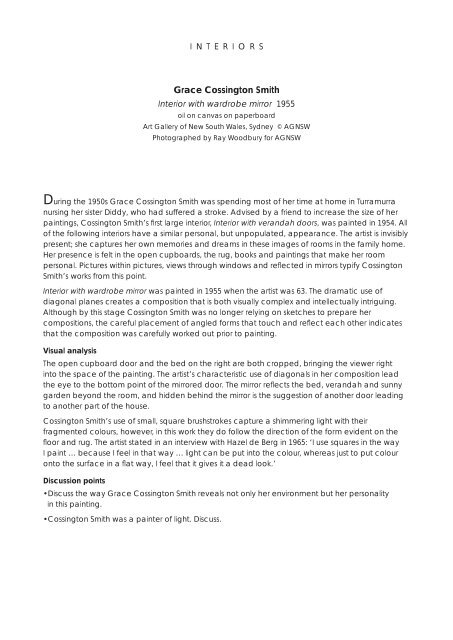Grace Cossington Smith - National Gallery of Australia
Grace Cossington Smith - National Gallery of Australia
Grace Cossington Smith - National Gallery of Australia
Create successful ePaper yourself
Turn your PDF publications into a flip-book with our unique Google optimized e-Paper software.
INTERIORS<br />
<strong>Grace</strong> <strong>Cossington</strong> <strong>Smith</strong><br />
Interior with wardrobe mirror 1955<br />
oil on canvas on paperboard<br />
Art <strong>Gallery</strong> <strong>of</strong> New South Wales, Sydney © AGNSW<br />
Photographed by Ray Woodbury for AGNSW<br />
During the 1950s <strong>Grace</strong> <strong>Cossington</strong> <strong>Smith</strong> was spending most <strong>of</strong> her time at home in Turramurra<br />
nursing her sister Diddy, who had suffered a stroke. Advised by a friend to increase the size <strong>of</strong> her<br />
paintings, <strong>Cossington</strong> <strong>Smith</strong>’s fi rst large interior, Interior with verandah doors, was painted in 1954. All<br />
<strong>of</strong> the following interiors have a similar personal, but unpopulated, appearance. The artist is invisibly<br />
present; she captures her own memories and dreams in these images <strong>of</strong> rooms in the family home.<br />
Her presence is felt in the open cupboards, the rug, books and paintings that make her room<br />
personal. Pictures within pictures, views through windows and refl ected in mirrors typify <strong>Cossington</strong><br />
<strong>Smith</strong>’s works from this point.<br />
Interior with wardrobe mirror was painted in 1955 when the artist was 63. The dramatic use <strong>of</strong><br />
diagonal planes creates a composition that is both visually complex and intellectually intriguing.<br />
Although by this stage <strong>Cossington</strong> <strong>Smith</strong> was no longer relying on sketches to prepare her<br />
compositions, the careful placement <strong>of</strong> angled forms that touch and refl ect each other indicates<br />
that the composition was carefully worked out prior to painting.<br />
Visual analysis<br />
The open cupboard door and the bed on the right are both cropped, bringing the viewer right<br />
into the space <strong>of</strong> the painting. The artist’s characteristic use <strong>of</strong> diagonals in her composition lead<br />
the eye to the bottom point <strong>of</strong> the mirrored door. The mirror refl ects the bed, verandah and sunny<br />
garden beyond the room, and hidden behind the mirror is the suggestion <strong>of</strong> another door leading<br />
to another part <strong>of</strong> the house.<br />
<strong>Cossington</strong> <strong>Smith</strong>’s use <strong>of</strong> small, square brushstrokes capture a shimmering light with their<br />
fragmented colours, however, in this work they do follow the direction <strong>of</strong> the form evident on the<br />
fl oor and rug. The artist stated in an interview with Hazel de Berg in 1965: ‘I use squares in the way<br />
I paint … because I feel in that way … light can be put into the colour, whereas just to put colour<br />
onto the surface in a fl at way, I feel that it gives it a dead look.’<br />
Discussion points<br />
•Discuss the way <strong>Grace</strong> <strong>Cossington</strong> <strong>Smith</strong> reveals not only her environment but her personality<br />
in this painting.<br />
•<strong>Cossington</strong> <strong>Smith</strong> was a painter <strong>of</strong> light. Discuss.
















